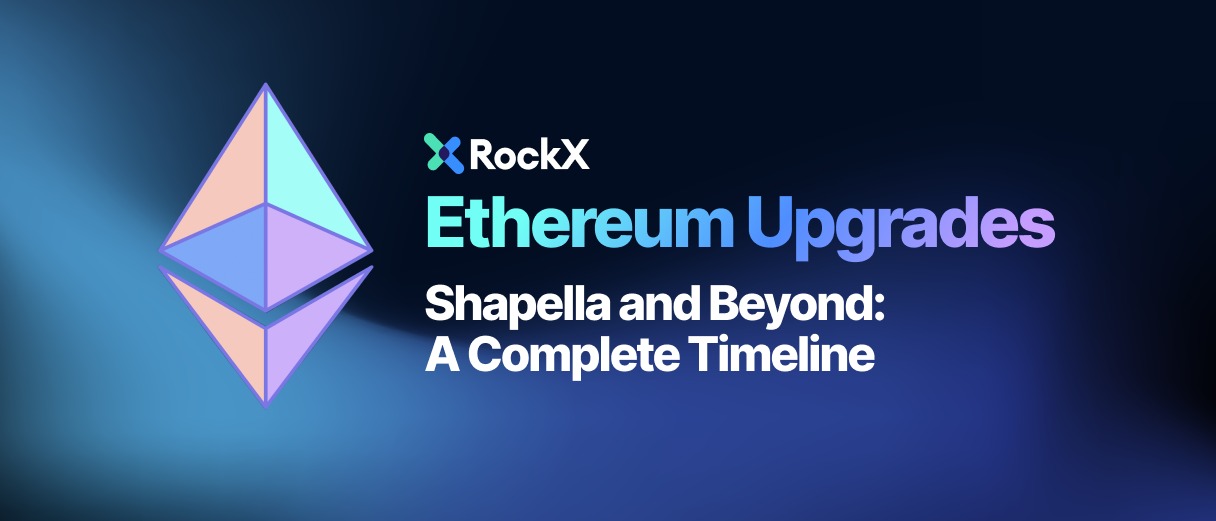The upcoming Ethereum (ETH) Shapella Upgrade is a major milestone for the Ethereum blockchain network. This upgrade is essential in improving the network’s scalability, security, and sustainability. However, the Shapella Upgrade is just one part of a series of upgrades that have been made and will continue to be made to the Ethereum network.
In this article, we will explore the history of Ethereum upgrades, including significant milestones, such as the launch of the Ethereum mainnet, the implementation of EIP-1559, and the introduction of the London hard fork. We will also delve into why these upgrades are essential for the Ethereum network and how they will impact the Shapella Upgrade.
Overall, this timeline will provide a comprehensive overview of the past, present, and future of the Ethereum network and why it is so crucial for the blockchain industry as a whole.
ETH 2.0 Upgrade to Proof of Stake

Ethereum is the second-largest cryptocurrency which was founded in 2015 as a “Proof-of-Work” (PoW) network. In 2021, the deployment of Ethereum’s London hard fork and EIP-1559 served as a significant milestone towards Eth 2.0, which reduced the supply of ETH and put deflationary pressure on the Ethereum network.
Then in Dec. 2020, the first stage of the next-generation PoS Ethereum 2.0 went live with the launch of Beacon Chain. It was on September 15, 2022, with “the Merge” upgrade, that Ethereum’s long-awaited migration from its current PoW consensus mechanism to a “Proof-of-Stake” (PoS) system finally happened.
What does it mean for ETH?
Under the PoW system, miners compete to solve complex mathematical problems to add new blocks to the blockchain. In contrast, the new PoS consensus mechanism allows network participants to become validators by staking their Ether (ETH) to participate in block validation.
Validators are selected based on the amount of ETH they have staked and are responsible for verifying transactions and adding new blocks to the blockchain. They earn rewards for their participation, and their stake acts as collateral to ensure the integrity of the network.
The PoS consensus mechanism is more efficient and environmentally friendly, requiring significantly less computational power and energy consumption than PoW. Additionally, PoS makes it easier for more participants to participate in the validation process, as it requires less specialised hardware and technical knowledge. This leads to a more decentralised network and an increase in its transaction throughput.
One of the key issues with the current Ethereum network is its limited capacity of around 30 transactions per second (TPS), which can cause delays and congestion. The upgrade promises to address this problem by increasing the network’s capacity to 100,000 TPS by implementing shard chains.
Scalability is not the only focus of Ethereum 2.0. It also aims to improve network security by requiring a minimum of 16,384 validators, making Ethereum more decentralised and, thus, more secure.
In addition to scalability and security benefits, the increased network usage resulting from the upgrade is expected to create more demand for Ether. This, in turn, could drive the price of Ethereum higher, at least in theory.
Shapella Upgrade

The Ethereum network is now set to undergo a significant upgrade known as the Shapella upgrade, with activation scheduled for April 12. This upgrade is a combination of two separate upgrades, the Shanghai and Capella upgrades, aimed at improving the consensus layer and the execution layer of the Ethereum network, respectively.
This upgrade, a critical step following the Merge, will allow users to take advantage of the full benefits of Proof-of-Stake.
Biggest Impact of Shapella
One of the most significant changes introduced by the Shapella upgrade is EIP-4895, which will enable the withdrawal of staked ether for the first time ever. Since the launch of ETH staking in December 2020, users have been unable to unstake their staked ETH, even after the network transitioned from PoW to PoS. The upcoming Shapella upgrade will finally allow users to withdraw their staked ETH, thereby freeing up their funds for other uses.
Over the last two years and four months, the Ethereum network has received a deposit of about $30 billion worth of ETH, accounting for about 14.67% of all ETH in circulation. Now, the Shapella upgrade will finally enable staked ETH to be withdrawn, and based on the successful execution of the Goerli testnet, the transition is expected to go smoothly.
Validators who wish to withdraw can choose a one-time withdrawal option, in which they can withdraw their Ether rewards exceeding 32 Ether while continuing to validate or opt for a complete withdrawal, taking the entire 32 Ether and rewards and ceasing validation activities altogether.
Effect of ETH Withdrawals
While some crypto investors fear that unlocking and withdrawing staked ETH could create significant selling pressure for ETH’s price, others are of the view that anticipated outflows are unlikely to cause major selling pressure and crash the price of ETH.
According to Nick Hotz of Arca, withdrawals and inflows from new stakers will be netted out. He further explained that the impact of ETH outflows would not be immediate because withdrawals will have to go through a queue, which means only 10% of the total amount of staked ETH can be removed from the pool in a month.
On top of it, people will need time to understand how Shanghai works. Not to mention, Ethereum’s withdrawal system (a two-tier withdrawal system, with partial withdrawals above 32 ETH usually executed immediately, while full withdrawals will take more time and be released gradually) severely limits the amount of ETH withdrawn at a time.
Coinbase, which is responsible for a large portion of the staked ETH on the network, has also warned that it could take several months to complete withdrawal requests, depending on user demand. Therefore, users should be prepared to exercise patience as they navigate the process of withdrawing their staked ETH.
The emergence of liquid staking derivatives (LSD), which let ETH stakers keep their investments liquid and trade by issuing derivative tokens such as stETH, could also dampen the outflows. In fact, the certainty and flexibility of staking ETH can bring new stakers online, outpacing withdrawers.
Greater scalability and security for ETH
The upcoming Ethereum Shanghai upgrade is not just about allowing withdrawals for staked Ether, though. It’s also a major development in Ethereum’s move towards greater scalability and security.
Additionally, the Shapella upgrade includes network improvements to optimise transaction fees for certain activities. These upgrades have been tested on multiple testnets, and the Ethereum Foundation recently doubled the bug bounty reward to $500,000 to encourage security researchers to identify and report any vulnerabilities before the upgrade is activated.
To benefit from the Shapella upgrade, stakers and non-stakers who operate nodes must upgrade their nodes to the latest Ethereum client versions. This upgrade is crucial to ensure that the network can handle the new features and optimisations introduced by the upgrade.
Future Upgrades

The future of Ethereum is difficult to predict, as the roadmap has been subject to changes due to the industry’s dynamic nature. Initially, the Ethereum Foundation had planned to launch shard chains before the Merge event.
However, the boom of layer 2 scaling solutions made them change their minds, prioritising the swapping of PoW to PoS via the Merge event. The journey to Ethereum 2.0 has seen several updates, with the focus now primarily on development.
According to Ethereum co-founder Vitalik Buterin, the current challenges surrounding Eth 2.0 are increasingly about development, which will only grow over time. He previously noted that Eth 2.0 would need to rely on current scaling methods, such as ZK-rollups, for at least two years before implementing shard chains.
More upgrades to Come
In July 2022, Buterin shared his vision for the network’s future developments beyond the “Merge” at the Ethereum Community Conference in France. Buterin stated that Ethereum is just 40% complete, and plenty more will come after the Merge.
The merge was just the first in a series of planned upgrades, which Buterin has named — the surge, verge, purge, and splurge.
The surge refers to the addition of Ethereum sharding, which is a scaling solution that will enable cheaper layer-2 blockchains and make it easier for users to operate nodes that secure the Ethereum network. And once the surge is complete, the Ethereum network will process transactions faster, and it’s expected to process up to 100,000 TPS.
The Verge will implement Verkle trees and stateless clients, allowing users to become network validators without storing extensive amounts of data on their machines. This upgrade will be great for decentralisation.
The purge, on the other hand, will involve a purge of old network history, trying to simplify the Ethereum protocol over time and not requiring nodes to store history. This phase aims to cut down the amount of space required on a hard drive.
Lastly, the splurge is where all the other fun stuff will be. Buterin did not provide specific details about what this phase would entail, but it’s expected to bring more exciting developments to the Ethereum network.
Conclusion

Ethereum has undergone several upgrades over the years, each bringing security, scalability, and efficiency improvements. The upcoming Shapella upgrade is yet another significant upgrade, as it will mark the full transition of Ethereum to a PoS network, making it more energy-efficient and scalable. Additionally, it will introduce new features, such as shard chains, which will allow for faster processing of transactions.
Already staking has started to make an impact with not just individuals but also institutions gearing up to take advantage of high staking interest rates compared with traditional banking. As more users become validators than ever before, participating in the Ethereum network, this participation could then expand to other networks, resulting in more participation across the crypto industry.
While the long-term effects of Eth 2.0 are left to speculation, the better the network gets, the more value is exchanging hands at all times.
Given their significance, it is essential for Ethereum network users to be aware of these upgrades and to prepare for them accordingly. This includes keeping up to date with the latest developments and making necessary changes to their software or hardware to ensure compatibility.
Being prepared for future upgrades will help ensure a smooth transition and allow users to take full advantage of the new features and improvements that these upgrades bring.
Overall, Ethereum’s ongoing commitment to improving its network through regular upgrades and innovations makes it a promising platform for developing decentralised applications and the future of blockchain technology.









